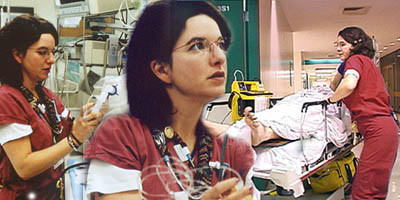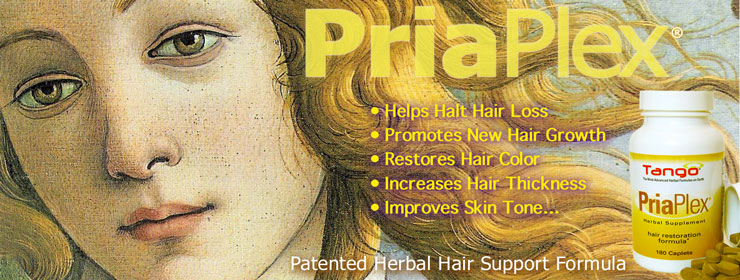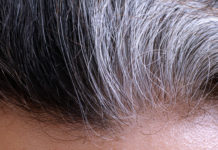Amy Petrarca, MS, RN, L.Ac, Dipl. OM
 |
| Fig. 1: Photo by patient prior to treatment. |
“Janie” was clearly suffering when we first met. Entering my office she appeared embarrassed, with long pieces of hair wrapped around her head in an attempt to cover up her bald spots. As she described her situation in a shy, soft-spoken voice, it became clear that she was going through a very stressful time.
Janie explained that it had been eight months since the initial onset of her Alopecia Areata (AA), an autoimmune disorder in which the body’s immune system attacks hair follicles, resulting in clearly defined bald patches across the scalp. Western treatments for AA include topical as well as injected steroids. Other “tips” for managing AA involve covering the scalp with wigs, hats and scarves, and reducing stress, which is believed to exacerbate the condition.
Janie first learned of her problem when her husband pointed out that she was losing hair on the top of her head. Over time her AA progressed from her crown to include the hairline, just above the forehead, as well as the occipital ridge and the area just above her right ear. In time her hair loss became very noticeable and difficult to cover-up.
When I first examined Janie’s scalp areas with a magnification lens I was surprised to find tiny, fine white hairs growing in the affected areas. This was especially interesting since Janie is young — only 31-years-old — with no other white hairs among the mousey-brown hair covering the rest of her head.
Prior to contacting me Janie had been under the care of a dermatologist for five months. Her treatment primarily consisted of steroid injections directly into the affected scalp – a painful process that clearly wasn’t working. As a result, Janie was sad, scared, and eager to find a solution for her condition.
As I interviewed her a clear picture of Janie’s life began to emerge. As a 31-year-old marketing professional she typically worked a 40-hour week, subsisting on a Standard American Diet (SAD) consisting of breads, cheese, packaged foods, sandwiches, alcohol and sweets, augmented with caffeine and cigarettes. As the 7th of 8 children in her family, she had suffered from frequent ear infections during childhood, which resulted in rounds of antibiotic therapy.
I told Janie that I believed I could help her, and proceeded to make the following recommendations:
- First, I wanted her to clean up her diet by eliminating processed meals and other foods known to promote inflammation and negatively affect the immune system.
- Second, I implemented a stress-reduction program that included promoting good quality sleep.
- Next, the use of guided imagery and acupuncture treatments for 4 to 6 weeks to restore and equalize her immune system.
- And finally, select supplements and botanicals to enhance the constitutional support needed to stop the autoimmune process and facilitate new hair growth.
I asked her if she would be interested in working with botanicals to help with the hair re-growth. Janie was agreeable to trying the herbs.
I prescribed a supplemental strategy for her that including Omega-3 oils, gamma linoleic acid, vitamin D, a proper multi-vitamin, and a unique hair-support formula called PriaPlex®, which includes:
| Common Herb Name (Latin Name) | (Pin Yin Name) | |
| Ligustrum fruit (Ligustrum lucidum Ait.) | Nu Zhen Zi | * |
| Eclipta herb (Eclipta prostrata L.) | Han Lian Cao | * |
| Astragalus root (Astragalus membranaceus (Fisch.) | Huang Qi | * |
| Dong quai root (Angelica sinensis (Oliv.) Diels) | Dang Gui | * |
| Rehmannia root (Rehmannia glutinosa) | Sheng Di Huang | * |
| Asian ginseng root (Panax ginseng) | Ren Shen | * |
Janie was determined to get results and 100% compliant with her prescribed treatment regimen. She came in for weekly acupuncture treatments and took the herbs and supplements as prescribed. She implemented stress reduction strategies and was newly mindful of her diet.
 |
| Fig. 2: “Janie” after 3 months of treatment involving acupuncture and PriaPlex®. Photo by Amy Petrarca, BiaoHealth. |
After the first three weeks of treatments, new healthy brown hair growth was evident. Looking through the magnifying lens, I could see the new hair growth in each of the bald spots on her head. After one month of treatment Janie informed me that she was cancelling all future appointments with her dermatologist, exclaiming, “No more steroid injections for me!”
Janie was enjoying her acupuncture sessions and herbal therapy. She was obviously benefiting from the results as evidenced by the new hair growth as well as a notable change in her demeanor. She rated her stress level “lower” than when we first met, and seemed less tense with each visit to my clinic.
By the end of the second month of treatment, when Janie walked into to my clinic I barely recognized her! Her eyes were shiny and bright as she walked in, confidently sporting a brand new, short hair cut. She smiled, gave me a hug and said, ”My hairstylist wants your business card! Thank you so much for helping me.”
References:
- Bensky, D., Clavey, S., and Stoger, E. (2004). Chinese Herbal Medicine Materia Medica. (3rd Edition). Seattle, WA. Eastland Press. p. 710, 718.
- Bensky, D., and Barolet, R. (1990) Chinese Herbal Medicine Formulas and Strategies, Seattle, WA, Eastland Press, p. 273, 274.
- Gongwang, L., and Hyodo, A.(1994) Fundamentals of Acupuncture & Moxibustion, Nankai District, Tianjin, P.R. China. Tianjin Science and Technology Translation and Publishing Corp. p 58, 59.
- Taber’s Cyclopedic Medical Dictionary. (18th Edition). (1997). F.A. Davis Company., p. 70
Janie’s Case From a Traditional
|
 |
| Amy M. Petrarca (above) runs BiaoHealth Acupuncture in San Francisco, California. After graduating from Auburn University School of Nursing in 1993, Amy obtained her professional nursing experience at some of the most reputable hospitals including: The Cleveland Clinic, Brigham & Women’s Hospital, Massachusetts General Hospital, and currently works in the Emergency Room at San Francisco General Hospital. (Image: Amy Petrarca in San Francisco General Hospital ER, from the PBS documentary, “Loving the Night Shift.” |













